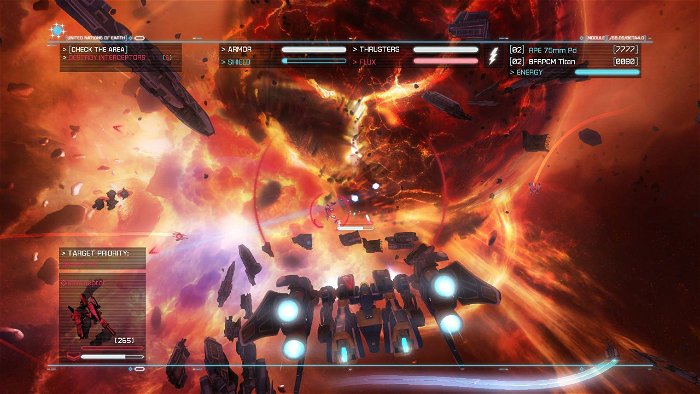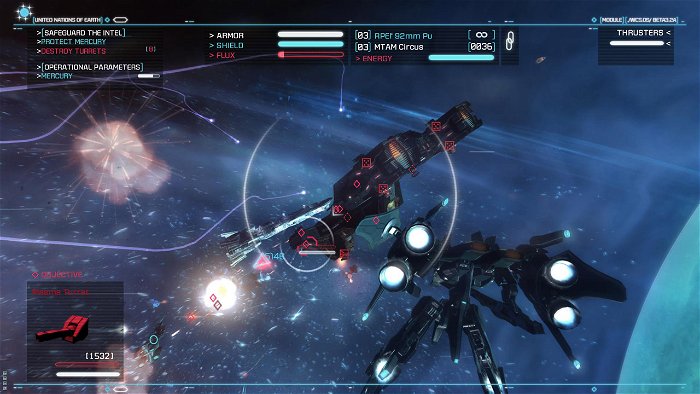Get Back In The Cockpit
For one type of gamer, there’s no point in writing this review at all, it’s a guaranteed buy. That’s the kind of gamer that played games like Colony Wars on the PS1 and X-Wing and/or TIE-Fighter on the PC religiously. These are the gamers that have been even more underrepresented than JPRG fans or rhythm game fans not just for one console generation but a few. These are the starfighter combat fans, the ones that dreamed of hopping in a ship, taking to the stars and shooting enemy fighters while attempting to take down massive capital ships. Those players finally have a new game to play with Strike Suit Zero: Director’s Cut and while they’ve already bought the game, here’s what other people need to know about this rare incursion into a genre that’s once again coming back to life; this game ain’t bad at all.

Earth Versus The Colonies… Again.
Strike Suit Zero: Director’s Cut is not a brand new game. This indie title debuted early last year on the PC after a successful Kickstarter campaign. Unfortunately, there were some balance and pacing issues with the game at the time that kept it from achieving its full potential. However, thanks to the power of fan input, numerous patches and a second chance to bring the game out on the new generation of consoles, Strike Suit Zero now has the opportunity to properly present itself to a new audience, and it succeeds.
The story here, while not terrible, is not particularly engaging either, falling back on established science fiction tropes to set the tone and give the player an excuse to start dog fighting in space. As often happens in the world of science fiction, Earth has rapidly expanded its influence among the stars, and its colonies eventually go to war for independence. Players take on the role of “Adams,” an insubordinate combat pilot who, like game heroes of old, says absolutely nothing during the entire course of the game. And with that, the game spins into a tale that starts with Adams learning how to steer a fighter and spirals into a hodgepodge of internal conflict between commanding officers, mysterious artificial intelligences, and top-secret super weapons capable of planet busting amounts of destruction. None of it is particularly original, but when players have waited this long to get in the cockpit of a starfighter, any plot will do. This one pushes all the necessary buttons to move from one battle to the next, though it fails to engage the player in any meaningful way as classics like The Last of Us have done.

Moving over into the presentation aspects of the game, Strike Suit Zero: Director’s Cut presents gamers with a world that is full of color, but is far from a visual powerhouse. This is an indie title, made by a small crew who asked for a modest amount of money. It’s not a AAA powerhouse with a team of hundreds, nor is it Chris Roberts—creator of Wing Commander and running his own crowd-funding campaign—sitting atop a pile of $40 million (he only wanted $500,000). The game does look pretty, with smooth, with streamlined ship designs, plenty of color, and most importantly, a rock solid performance of 60 frames per second at 1080p.
***
Barrel Rolls & Missile Locks
The main event of Strike Suit Zero: Director’s Cut is, of course, the chance to hop in the cockpit of a starfighter and engage in some space battles with interceptors and capital ships. The big differentiator here is the Strike Suit itself; basically a fighter that also transforms into a giant robot. Yes, it’s shades of Gundam/Macross, but it’s also something so rarely done in a game—let alone done right—that this anime cliché still feels fresh here.
Most of the basic mechanics of SSZ are straight out of the traditions of Wing Commander and Colony Wars. Players have the choice of a cockpit or third-person/behind the ship view. Energy shields eat up the initial damage, and when those fail, armor absorbs the rest. Weapons are a combination of bullet-based cannons, pulsed energy weapons and missiles. All of this is standard stuff for the genre, but they are nicely balanced so that each weapon has specific instances when one choice is better than another. These combat mechanics are combined with different craft that specialize in dog fighting, or laying out slow but powerful torpedoes that can take down the capital ships. Again, nothing new here, but the balance—probably due to player input in the months since release—has been tweaked to feel right. Each weapon and fighter has a distinct feel in terms of speed and handling, and while the combat is fast paced and fun, it jumps up a notch when the Strike Suit enters the mix. By killing enemies—or simply traveling around—a “Flux” meter builds up. When enough flux energy has accumulated, a press of the button converts the fighter craft into its giant robot/Strike Suit configuration, and this feels radically different from the fighter. It’s insanely powerful, extremely maneuverable, and capable of taking out multiple targets all at once with a destructive light show of missiles or beam weapons on par with anything seen in classic, giant robot anime.

Combat has clearly been tuned for hardcore gamers. The difficulty starts out reasonable enough, but as the plot escalates, so does the challenge. This game has true fleet combat, with fighters, corvettes, frigates, cruisers and carriers all waging war with each other while the player rushes about executing mission objectives. It gets hectic, and it demands focus and skill from the players, but, like any traditional hardcore game, the game may be tough, but it’s not unfair. Defeat comes from player error, not broken game systems. Even the dreaded escort mission, usually the worst activity in any combat game, has been evened out with tougher, more durable ships to guard, so players can actually break away from time to time without worrying about their charge blowing up the second a stray enemy shows up.
***
For what it is, Strike Suit Zero: Director’s Cut is a well-balanced, challenging game that scratches the long unattended space combat itch. It’s not innovating in any way and lacks even the soap operatic allure of later Wing Commander games that featured Mark Hamill and Malcolm McDowell hamming it up in overblown plotting. What it does provide is an extremely competent, fast paced and challenging space combat experience for console gamers, something that hasn’t been available for years. The game is only $20—or $17 if you subscribe to PlayStation +—and manages to provide excellent value for the price. It’s not a short game, nor is it an easy one, and it manages to competently nail the excitement of space combat while avoiding the looping/turning battles that dogfights can often turn into, thanks to ability to turn into a giant robot. Strike Suit Zero: Director’s Cut doesn’t have the highest budget, or production values compared to the big games of today, but it’s got it where it counts; it’s a well-tuned space combat at period in gaming where games in this genre are a rarity. Space combat fans can buy this immediately. Anyone else curious about what it’s like to jump in a starship and start dogfighting should also pick this up.
Check out Wayne’s entire review in the May issue of CGMagazine.






